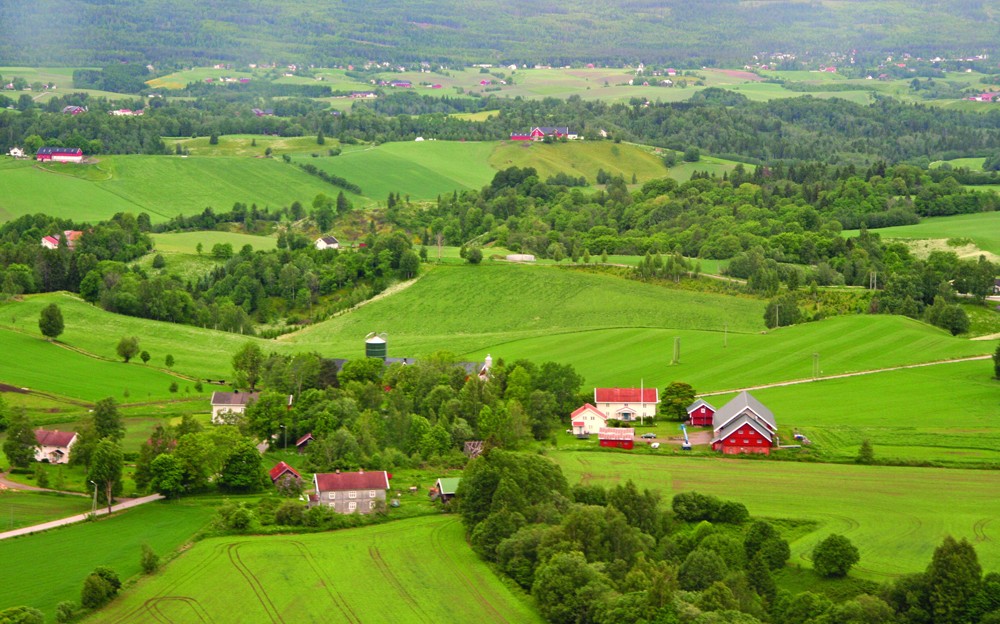
Spring in eastern Norway. Photo: Odd Iglebaek
Approximately 90% of the territory of the European Union is defined, in one way or another, as 'rural'. The movement of the population from the land to the cities is nevertheless continuing with now only 30% (150 million) of the EU 27 population living in these broadly defined 'rural' areas. In general, the poorer the region, the more likely it is to be 'rural'.
For many years the CAP was the economic backbone of the EU's redistributive policy strategy. Many would however argue that too much of these subsidies were, and still are, transferred to already very rich farmers/landowners It is often said that 80% of the CAP funds go to only 20% of the farmers. "Mountains" of butter, wheat, meat or wine have historically represented this concentration on 'production' or 'output' at the expense of other less prosaic factors.
Until 1992 CAP transfers represented nearly 49% of the EU's budget. By 2013, the CAP's share of the budget is projected to decrease to 32%. In contrast, the EU's various regional development instruments, which accounted for only 17% of the budget in 1988, will assume almost 36% in 2013. How, and to which extent, this has changed rural life within the Union remains however unclear.
What lies ahead for the rural regions of Europe and in particular for those in the Nordic countries? This issue is discussed in a number of the articles in this issue of the Journal of Nordregio. On pp 12-13 the CAP's future is examined. The authors, Hilkka Vihinen and Petri Kahila, suggest that future transfers will likely be on a flat-rate basis and less linked to the production of specific crops. There will also be more concentration on the quality of food and relatively less on absolute volumes produced. There may also be a new 'pillar' devoted to energy and climate change.
In the article on pp 14-15 Andrew Copus argues that with one or two exceptions national or regional rural development programmes remain sectoral rather than territorial. This does not reflect all the differences in the local rural economy, and hence should be adjusted, in particular if the aim is to reduce the number of people leaving the countryside.
A rural focus is also maintained in the articles focusing on the Nordic area. On pp 4-7 we take a closer look at the similarities and differences in the official definitions of 'rural' areas in Denmark, Finland, Norway and Sweden. The overall aim for these countries is to sustain their rural areas (pp 8-9), however policies to achieve this vary (pp 9-10).
The introduction of bulk containers has fundamentally altered the world of shipping. One implication is that volumes (in dwt) have doubled in the last few decades. Denmark, Norway and to some extent also Finland have developed new strategies for the maritime sector. Recently Nordregio's Maria Lindqvist has finalised her study of how Sweden is attempting to change its maritime strategy. The results are presented on pp 16-19.
One year ago the Journal of Nordregio, No 2-2009, took a closer look at city centre densification and high-rise buildings in the Nordic capitals. In this volume we also look at the concurrent debate taking place in the Baltic capitals. This is a subject which has generated heated debate during the last congregation of Metrex – The network of European Metropolitan Regions and Areas – which met in Vilnius and Riga in May this year.
During the Soviet era a few high-rise structures were erected in the centre of these capitals, however only one or two in each city, and too few to really change the skyline.
After independence in 1991 the old towns of Riga, Tallinn and Vilnius were all accepted onto the prestigious UNESCO list of World Heritage Sites. But "peace" did not last long. With the reintroduction of private landownership and the possibility to engage in property speculation the skylines of these towns soon began to change – often quite significantly Modern, corporate, high-rise developments emerged to challenge the silhouettes created by the towers of historical churches or town-halls. We report on the ongoing debates this change has rendered.
Odd Iglebaek, Editor